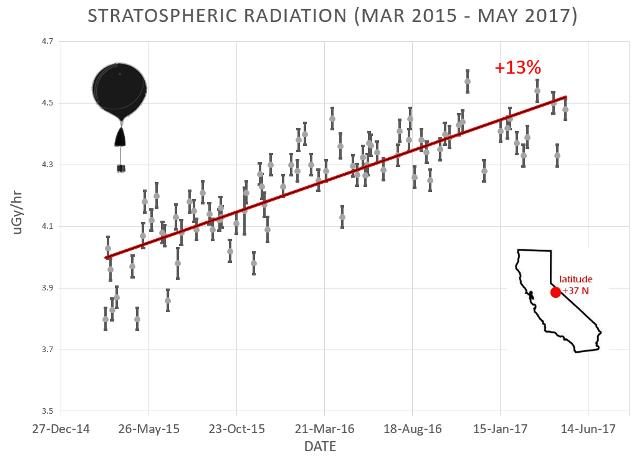Sometimes called "space lightning," sprites are a true space weather phenomenon. They inhabit the upper atmosphere alongside auroras, meteors and noctilucent clouds. Some researchers believe they are linked to cosmic rays: subatomic particles from deep space striking the top of Earth's atmosphere produce secondary electrons that, in turn, could provide the spark that triggers sprites.
According to the website SpaceWeather the link to cosmic rays is particularly interesting at this time. Despite a brief reduction in cosmic rays last week caused by the sweeping action of a passing CME, cosmic rays are intensifying. For the past two years, space weather balloons have observed a steady increase in deep space radiation penetrating our atmosphere.
This increase is largely due to the decline in the solar cycle. Flagging solar wind pressure and weakening sunspot magnetic fields allow more cosmic rays into the inner solar system--a trend which is expected to continue for years to come. These changes could add up to more sprites.
It is likely that increasing cosmic rays are also affecting weather around the planet.
Comment: Extreme weather 2017 caused by cosmic rays not CO2, the grand solar minimum amplifying effect
Some other transient luminous events (TLEs) recorded so far this year include:
July 2017: Amateur astronomer films extremely rare space lightning over Australia.
June 2017: Red jellyfish sprites captured over Austria and red sprites recorded over English Channel.
April 2017: Rare ELVE and red sprites captured in Czech Republic and 6 'gigantic jets' (ionospheric lightning) were photographed in Western Australia.
March 2017: A huge blue jet was observed over Brazil.




Comment: See also: Electric universe: Lightning strength and frequency increasing
The Electric Universe model is clearly explained, with a lot more relevant information, in the book Earth Changes and the Human Cosmic Connection by Pierre Lescaudron and Laura Knight-Jadczyk.